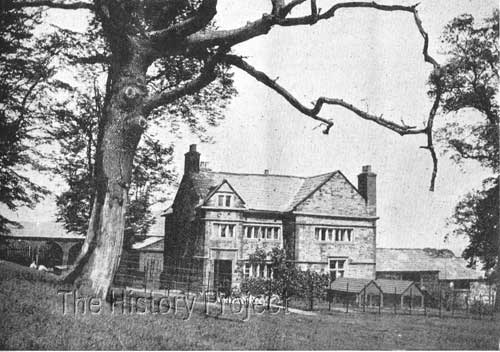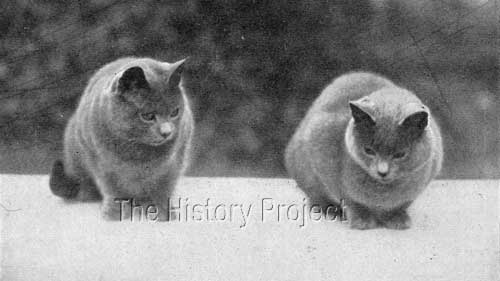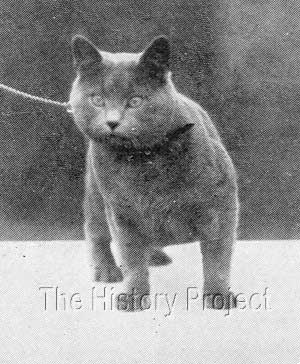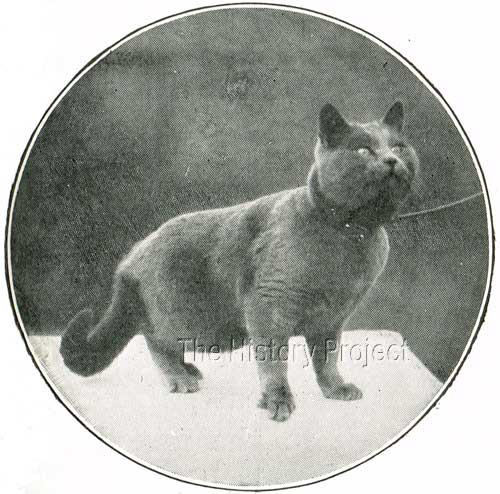 | ||||||||||||||









|
SHERDLEY MICHAEL (1901)PHOTOS | SOCIAL MEDIA | REFERENCES
HISTORICAL BACKGROUND:During the late nineteenth and early twentieth century, the development of the Blue Shorthair was unquestioningly controversial and frought with difficulty. Unlike the blue Longhair, which developed in type along Persian lines, the blue shorthair had a mixed history of type and styles. Mrs. Carew Cox, who historically is seen as the cultivator and preserver of the Russian Blue variety was of the opinion that all of the original blue shorthairs were of foreign extraction. In the main, these were from northern Russia, but also from Scandinavia, Iceland, Malta, and a number of European climes. These blues were shown from the earliest of times, sometimes featuring in show reports dating from the late 1870's and were, at that time, nearly always referred to as Russians, or Foreign Shorthairs. However, as the English Shorthair took hold in other colours at home, (bred for its recognizable stockier conformation, with shorter legs, broader head and lower ear set), blues of this variety were ultimately produced from matings between whites and blacks, and from crosses between shorthaired and longhaired cats, as well as from original English shorthairs which carried dilute. In 1903, Francis Simpson alludes to the two types that resulted in her chapter on blue shorthairs: "That there are two types of these blue cats is apparent to anyone who observes the specimens exhibited at our shows. The foreign or imported variety had wedged-shaped faces, and are longer and larger in the head, with prominent ears, otherwise in colour and coat, they are similar to those bred in England, which partake of the same formation as an ordinary British cat."1 But even in 1903, she lamented the lack of appropriate eye colour in what she perceived to be the English style of blue shorthair. "The blues now exhibited appear generally to fail in eye, the colour being yellow, and often green or greenish-yellow; whereas a special feature of this breed should be a deep orange eye, round and full."1 We might forgive her bias a little for she was the most ardent supporter of record for the Blue longhair, for which deep orange eyes was considered more and more, a valuable prerequisite. Frances also singles out Lady Alexander (Ballochmyle), Mrs. Hughes (Sherdley). and Mrs. Carew Cox as the three principle breeders of blue shorthairs at that time. In truth, both Lady Alexander and Mrs. Hughes were breeding their blues to the English standard, while Mrs. Carew Cox was devoted to preserving the alternative or 'foreign' type blue shorthair and the one and only accepted standard, favoured the former variety or type. This undoubtedly squeezed the Russian variety, once the doyen of blue shorthairs, almost to the point of extinction, while supporting the ongoing development of an independent English or 'British' blue! Hence many of the blue short-hair cats produced during this period can be found in the pedigrees of both varieties today, as forebears of both the 'British' Blue Shorthair, and the 'Russian' Blue Shorthair. PARENTAGE & OWNERSHIP:
Unknown
Acton Warrior
| Unknown
Sherldey Michael, May-25-1901, Blue Shorthair, M
| Sherdley Peter
Sherdley Sacha II
Sherdley Sacha I
Sherdley Michael's registration in Volume 6 of the NCC Studbook gives his date of birth as 25th May 1902.2 However, this is a clerical error which can be verified. His actual date of birth is 25th May, 1901 as he and 'Sherdley Alexis' were litter brothers born on the same date. This is verifiable from an article in Our Cats about the cattery at Sherdley Hall Farm, which when reviewing the cats in residence, unequivocably states: "We will be ungallant, and take the gentlemen first. Of these there are two - twins -Sherdley Alexis and Sherdley Michael. (Sherdley is the registered prefix of all the cats, and we will hereafter take the title for granted.) This fine pair were born in May, 1901, and are by Acton Warrior ex S.Sacha II."4 'Michael's' dam, Sherdley Sacha II (born 18th April, 1899), is by 'Sherdley Peter' and out of 'Sherdley Sacha I'5. Both the 'Sacha's' (mother and daughter) are shown further below.
Sherdley Hall itself has a long history. The house was formerly a monastery and many interesting relics of ancient days have apparently been found in the grounds. Sherdley Hall Farm, the house of the bailiff and the home of the cats, bears the date on its lintel of 1671, and the solid oaken door bears immediate witness, on entering, to the claim of antiquity. In speaking of the cats, the writer informs us: "Our visit today was not the first that we had paid to the Sherdley cats in their own domain, but this was purely a business call, in order to let out readers learn something about the remarkably fine kennel of blue short-hairs, which is, so-to-speak, in their midst. For this is what struck us so forcibly. One after the other the whole number were passed under review, and there is really not a poor specimen amongst them."4 "The photograph shows a couple of Boulton and Paul's cat houses, and several of these are in use. But all the cats, even the males, are allowed to run free every day, though their exercise has to be taken under supervision on account of the game. Mrs. Fazakerley, who has the entire charge, is certainly to be congratulated on the capital condition of all the cats under her care."4
The breeder and owner of the 'Sherdley' cats was Mrs. Michael Hughes. In fact, we have very little additional information about Mrs. Hughes, other than that in Frances Simpson's review of Blue Shorthairs in The Book of The Cat, she is listed as one of the three principal breeders of Blue Shorthaired cats alongside Lady Alexander of Ballochmyle and Mrs. Carew Cox. And it would appear that apart from making the decisions about the breeding and exhibiting of her cats, the care was very much left to the control of her at attendant, Mrs. Fazakerley. Of the two 'Sacha's', we are given the following background on these two matriarchs: "S. Sacha I, by Brookside Jim II., ex Brookside Tibby II., is the ancestress of all the Sherdley cats. She has seldom been shown, but has won several prizes. She and her litter took first and gold medal at the Botanic in 1899. It is easy to see where the Sherdley cats derive their beautiful colour, and Sacha I, also excels in head and shape. She is a beautifully shaped cat with round head and very large round eyes. But the gem of the females is Sacha II., who was one of the gold medal litter just mentioned, and has besides won second Crystal Palace, 1900, and first and cup at the Palace, 1902. S.Peter is her sire, and she is the mother of Mrs. Hughes' present stud, S. Michael and S.Alexis."4 SIBLINGS & SHOWS:As has already been indicated, 'Sherdley Alexi' and 'Sherdley Michael' were littermates, but they were not sole littermates. A female, known as 'Juliet' was also from the same litter. She, too, was originally retained by Mrs. Hughes for breeding, but was eventually sold to Mr. Burton Heap, and later known as 'Grove Juliet'.3
Of these three, we glean the following information from the article in Our Cats Magazine: "Alexis and Michael, though so young, boast a fine record in the show pen, competing in most cases with full-grown cats when they were in kittenhood. Alexis has won first in brace with Michael at the last Botanic Show, two seconds, one special, six thirds at the Botanic, Crystal Palace, Manchester, Richmond, and Glasgow. Michael's wins are first in brace at Botanic, first Manchester and two specials, two seconds and one third. Michael seemed to mature and fill out rather earlier than his brother, but this summer Alexis has caught up with him, for the latter is now the larger and more powerful cat of the two, and weighs 12-1/4 lbs. Both have quite unusually massive limbs and the broadest of heads. Michael is rather paler in colour, but perhaps loses a point to Alexis in texture of coat. The colour in all the Sherdley cats is remarkably good, and especially is this the case with the stud cats. They are a very fine pair, and in the pink of health and condition. "S. Juliet, a litter sister to Alexis and Michael, is a large cat for a female, very good in colour but rather poor in head. She has taken four seconds and two thirds, competing mostly with grown cats."4 Sire and Dam Siblings: 'Michael's' sire siblings by 'Acton Warrior'(CCR:v1) include:
Dam siblings , out of 'Sherdley Sasha II' included:
BREEDING & PROGENY:All of the progeny of record for 'Sherdley Michael' appear to come from two litters sired by him out of the same queen, 'Lady Henry'. These were born on 23rd October, 1902 and 20th April, 1903 respectively. They include in the first litter:
Then in the second litter:
We learn more about 'Lady Henry' and her contribution to the breeding program from the same article in 'Our Cats'. The litter mentioned in the article is in fact that which was born on 23rd October, 1902: "A basketful of four charming kittens were next introduced to us, sired by S. Michael, the mother being Lady Henry, a queen purchased by Mrs. Hughes at the last Westminster Show. Lady Henry won five first and many other prizes before her change of ownership, but has not been shown since."4 "The little basketful before us were too young to have begun the cares and struggles of show life, and were charmingly irresponsible and frolicsome. Here again we traced the splendid physique of the sire in a very marked degree. Lady Henry's strong points are her beautiful orange eyes. Her colour is not so good as that of the native Sherdley cats."4 PHOTOS:
SOCIAL MEDIA :
In Summary: Despite the fact that there was only one standard available to blue shorthairs in the late nineteenth and early twentieth century, regardless of having two distinctly different origins, and many exhibits having a mixed heritage containing both; the blue shorthair none-the-less remained a popular variety. Whether of the rounded, low set eared, heavier boned 'British' type; or the foreign, higher set eared, graceful lighter boned 'Russian' type, both varieties did ultimately survive this turbulent period of their history and in due course, both were granted separate standards and developed independently down a very divided 'conformation' path. Both are particularly loved for their amazing coat textures, which have also developed into very distinct and widely different types, so that there is no longer any muddying of the waters of recognition. It is fair to say that in assessing the phenotypical traits of the 'Sherdley' cats, they appear to be definitely more 'British' in style, with stockier build and bone. But whether you accept them as British or Russian shorthairs, what is most evident, is that they were consistently good and of robust build and constitution. In support of this view of the 'Sherdley' cats, the following letter written by Mr. Colin Campbell of the Scottish Cat Club affirms this view and illustrates clearly that the defining problem was the adoption and application of the one standard: (from Our Cats, 20th December, 1902) Blue Shorthairs Mr. Colin Campbell, at the request of one of our subscribers, is good enough to give us his views upon blue shorthairs. Mr. Campbell writes: "Some of the principal London clubs have a framed standard for a shorthaired blue variety, which they recognise as British, which, in point, is decidedly irregular as regards the true Russian. I thoroughly agree with the remarks of Mr. Sam Woodiwiss after the Palace show, stating that, in his opinion, a long, thin nose was the proper shape for the foreign blue variety, not the round head the club had made the standard. We have had ample opportunity in Scotland of judging imported Russians, and none ever having come under my observation agree with the standard of the British shorthaired blue variety. Hence my remarks in my report alluded to. To compare the two specimens in point: British - Blue shorthair. Head: Round and flat, with good space between the ears, which are small and well set on. Shape: Cobby in build, round quarters, and good in bone substance. Coat: Short and close, of sound blue colour throughout; legs and feet shade lighter in colour, with no bars or markings. Eyes: Deep orange in colour. Russian - Blue. Head longer in formation, has space between the ears, and well-tapered face; fairly round under the cheek bone, thin, falls away under the eye, and comes out rather longer in back; less bone substance, colour same as the British shorthair, with no bars or markings; eyes deep orange colour. To compare the two breeds, I consider Mr. McNish's St. Inan a true specimen of the Russian blue, and Mrs. M. Hughes' Sherdley Alexis a good specimen and well up to the standard of the British Shorthaired blue variety, only point failing in colour of eyes." 4 (Editor's bolding) One of the truest signs of success in any breeding program, is consistency. The breeders who produce a consistent, clearly identifiable style and type, are those whose cats will be remembered, and those that will ultimately leave a permanent genetic stamp upon the breed itself. These are the breeders who 'raise the bar', drawing 'a line in the sand' so-to-speak, from which there is generally no backward developmental movement. The 'Sherdley' blues successfully marked out a strong baseline for type and quality, setting in motion a drive to maintain it that has never since abated. REFERENCES:
Registers associated with this article include The Incorporated Cat Fanciers Association of Great Britain (TICFAGB), National Cat Club (NCC), The Cat Club (CCR), Beresford Cat Club (BCC), Feline Federation Francaise (FFF), Siamese Cat Registry (SCR), US Register & Studbook for Cats (USR)including Supplement(USRS), The Studbook of the American Cat Association (ACA), and the Studbook & Register of the Cat Fanciers' Association (CFA).
|
|||||||||||||
Home | Cats | Gallery | Clubs | People | Artifacts | Articles | Updates | Contact Us ©The CFA Foundation, Inc and The Harrison Weir Collection
|
||||||||||||||





